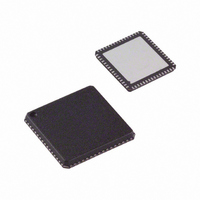AD9600BCPZ-105 Analog Devices Inc, AD9600BCPZ-105 Datasheet - Page 27

AD9600BCPZ-105
Manufacturer Part Number
AD9600BCPZ-105
Description
IC,A/D CONVERTER,DUAL,10-BIT,CMOS,LLCC,64PIN
Manufacturer
Analog Devices Inc
Datasheet
1.AD9600ABCPZ-105.pdf
(72 pages)
Specifications of AD9600BCPZ-105
Number Of Bits
10
Sampling Rate (per Second)
105M
Data Interface
Serial, SPI™
Number Of Converters
2
Power Dissipation (max)
650mW
Voltage Supply Source
Analog and Digital
Operating Temperature
-40°C ~ 85°C
Mounting Type
Surface Mount
Package / Case
64-LFCSP
Lead Free Status / RoHS Status
Lead free / RoHS Compliant
In some applications, it is acceptable to drive the sample clock
inputs with a single-ended CMOS signal. In such applications,
CLK+ should be driven directly from a CMOS gate, and the
CLK− pin should be bypassed to ground with a 0.1 μF capacitor
in parallel with a 39 kΩ resistor (see Figure 60). Although the
CLK+ input circuit supply is AVDD (1.8 V), this input is designed
to withstand input voltages of up to 3.6 V and therefore offers
several selections for the drive logic voltage.
Input Clock Divider
The AD9600 contains an input clock divider with the ability to
divide the input clock by integer values between 1 and 8. If a
divide ratio other than 1 is selected, the duty cycle stabilizer is
automatically enabled.
The AD9600 clock divider can be synchronized by using the
external SYNC input. Bit 1 and Bit 2 of Register 0x100 allow the
clock divider to be resynchronized either on every SYNC signal
or on only the first SYNC signal after the register is written. A
valid SYNC causes the clock divider to reset to its initial state.
This synchronization feature allows aligning the clock dividers of
multiple devices to guarantee simultaneous input sampling.
Clock Duty Cycle
Typical high speed ADCs use both clock edges to generate a
variety of internal timing signals. As a result, these ADCs may
be sensitive to the clock duty cycle. Commonly, a ±5% tolerance
is required on the clock duty cycle to maintain dynamic
performance characteristics. The AD9600 contains a duty cycle
stabilizer (DCS) that retimes the nonsampling (or falling) edge,
providing an internal clock signal with a nominal 50% duty
cycle. This allows the user to provide a wide range of clock
input duty cycles without affecting the performance of the
AD9600. When the SDIO/DCS pin functions as DCS, noise and
distortion performance are nearly flat for a wide range of duty
cycles, as shown in Figure 43.
CLK+
CLK+
Figure 60. Single-Ended 1.8 V CMOS Sample Clock (up to 150 MSPS)
Figure 61. Single-Ended 3.3 V CMOS Sample Clock (up to 150 MSPS)
50Ω
50Ω
0.1µF
0.1µF
VCC
VCC
1kΩ
1kΩ
1kΩ
1kΩ
AD9510/AD9511/AD9512/
AD9510/AD9511/AD9512/
AD9513/AD9514/AD9515
AD9513/AD9514/AD9515
DRIVER
DRIVER
CMOS
CMOS
0.1µF
OPTIONAL
OPTIONAL
100Ω
100Ω
39kΩ
0.1µF
0.1µF
0.1µF
CLK+
CLK–
CLK+
CLK–
AD9600
AD9600
ADC
ADC
Rev. B | Page 27 of 72
Jitter in the rising edge of the input is an important concern, and it
is not reduced by the internal stabilization circuit. The duty cycle
control loop does not function for clock rates less than 20 MHz
nominally. The loop has a time constant associated with it that
needs to be considered if the clock rate may change dynamically.
This requires a wait time of 1.5 μs to 5 μs after a dynamic clock
frequency increase or decrease before the DCS loop is relocked
to the input signal. During this time, the loop is not locked, the
DCS loop is bypassed, and the internal device timing is dependent
on the duty cycle of the input clock signal. In such applications,
it may be appropriate to disable the duty clock stabilizer. In all
other applications, enabling the DCS circuit is recommended to
maximize ac performance.
Jitter Considerations
High speed, high resolution ADCs are sensitive to the quality of
the clock input. The degradation in SNR at a given input
frequency (f
In this equation, the rms aperture jitter represents the root
mean square of all jitter sources, including the clock input,
analog input signal, and ADC aperture jitter. IF undersampling
applications are particularly sensitive to jitter (see Figure 62).
The clock input should be treated as an analog signal in cases
where aperture jitter may affect the dynamic range of the AD9600.
Power supplies for clock drivers should be separated from the
ADC output driver supplies to avoid modulating the clock signal
with digital noise. Low jitter, crystal-controlled oscillators make
the best clock sources. If the clock is generated from another
type of source (by gating, dividing, or another method), it
should be retimed by the original clock during the last step.
Refer to the AN-501 Application Note and the AN-756
Application Note for more in-depth information about jitter
performance as it relates to ADCs.
SNR
65
60
55
50
45
=
1
IN
−
MEASURED
20
Figure 62. SNR vs. Input Frequency and Jitter
) due to jitter (t
log
(
2
π
f
IN
INPUT FREQUENCY (MHz)
10
×
t
J
J
) can be calculated as
)
100
0.05ps
0.20ps
0.5ps
1.0ps
1.50ps
2.00ps
2.50ps
3.00ps
AD9600
1000













